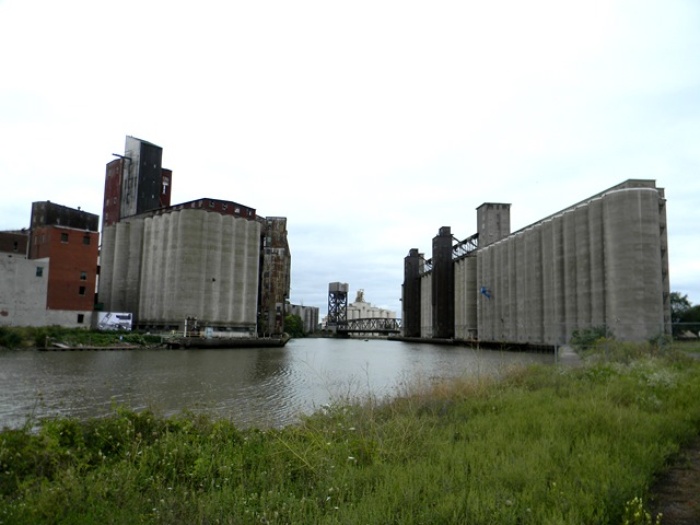|
Location |
| 100 Childs Street Buffalo, NY |
| On The Web |
| www.cityofnightbuffalo.com |
| Sponsors |
|
CIR Electrical Construction Corporation, Del Vecchio & Stadler LPP, Erie Canal Harbor Development Corporation, MASH Urgent Care, Arts Services Initiative of Western New York, Larkin Square, the John R. Oishei Foundation, theRobert Rauschenberg Foundation, 19 Ideas, Mead Supply, CooCooU/27 Chandler, Try-It Distributing, South District Council Member Scanlon’s Office, Urban Roots. |
This page was created as a class project for Com 336 at Buffalo State College.
The City of Night Art Festival is a one day only art festival that happens once a year. It is presented by ELAB (Emerging Leaders in the Arts of Buffalo). The art festival is held at “Silo City”, an important part of Buffalo’s architectural history. The silos are located at 100 Childs Street, Buffalo, New York. The first City of Night Art Festival was on September 8th 2012. In the following years the festival fell on August 17th, 2013, and June 28th, 2014. The date for next year’s festival is not set yet. The art festival opens at 4:00 PM and closes at 1:00 PM. The City of Night Art Festival mainly attracts people in their twenties or thirties who have a strong interest in any disciplines of art, and also with a connection to the rise of Buffalo’s artistic and cultural scene.
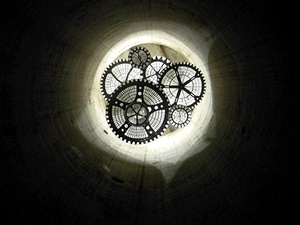 A hanging gear sculpture in one of the silos at the 2013 festival. - Photo by Gregory DeibelThe mission statement about the City of Night Art festival is: “City of Night is a multi-faceted event held at Silo City in Buffalo, NY, designed to promote art, culture, sustainability and history by igniting a connection between people and the places around them. Through the event, ELAB (Emerging Leaders in the Arts Buffalo) provides an opportunity to experience a significant place visitors might not otherwise explore in a spectacularly unique way. Our goal is to provide a lasting experience that will effect each visitor’s interaction with their community and the important places around them forever.”
A hanging gear sculpture in one of the silos at the 2013 festival. - Photo by Gregory DeibelThe mission statement about the City of Night Art festival is: “City of Night is a multi-faceted event held at Silo City in Buffalo, NY, designed to promote art, culture, sustainability and history by igniting a connection between people and the places around them. Through the event, ELAB (Emerging Leaders in the Arts Buffalo) provides an opportunity to experience a significant place visitors might not otherwise explore in a spectacularly unique way. Our goal is to provide a lasting experience that will effect each visitor’s interaction with their community and the important places around them forever.”
On the history of the Silos:
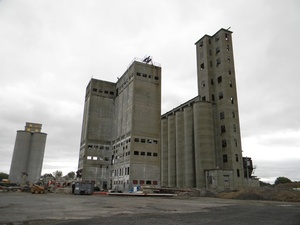 Photo by Gregory Deibel “What is now known as Silo City in the Old First Ward began in sections. It’s said that a ship captain could sail out into the lake, and, after about ten days, return to find a completely new, monumental building in place. Construction at this speed was previously unheard of, but state-of-the-art materials and techniques made it possible. At a ninety-degree bend in the Buffalo River, with first-generation wooden grain elevators standing sentinel nearby, is the reinforced concrete American grain elevator (once known as the Peavey). Built in 1906, it is now the second-oldest reinforced concrete elevator in Buffalo. Just east of the American, the Perot elevator was erected in 1907 by one of the earliest companies in the US; Anthony Morris II established his malting concern in 1687 in Philadelphia. Having thrived through many generations of family ownership, the firm decided to set up a division in Buffalo in order ‘to expand…take advantage of Buffalo’s good rail and shipping facilities, and be closer to Canadian and Midwestern barley sources.’ (Buffalo Courier Express, Aug. 5, 1951)
Photo by Gregory Deibel “What is now known as Silo City in the Old First Ward began in sections. It’s said that a ship captain could sail out into the lake, and, after about ten days, return to find a completely new, monumental building in place. Construction at this speed was previously unheard of, but state-of-the-art materials and techniques made it possible. At a ninety-degree bend in the Buffalo River, with first-generation wooden grain elevators standing sentinel nearby, is the reinforced concrete American grain elevator (once known as the Peavey). Built in 1906, it is now the second-oldest reinforced concrete elevator in Buffalo. Just east of the American, the Perot elevator was erected in 1907 by one of the earliest companies in the US; Anthony Morris II established his malting concern in 1687 in Philadelphia. Having thrived through many generations of family ownership, the firm decided to set up a division in Buffalo in order ‘to expand…take advantage of Buffalo’s good rail and shipping facilities, and be closer to Canadian and Midwestern barley sources.’ (Buffalo Courier Express, Aug. 5, 1951)
The two grain elevators situated on the farthest east side of the peninsula are the Marine A (1925), and the Lake & Rail (1927–1930). Marine A was built by the Abell family, who had a good deal of experience in the industry; William H. Abell launched the Western Elevating Association just after the Erie Canal opened in Buffalo. Their firm built a wooden grain elevator on the waterfront at the foot of Michigan Avenue in the early days of the trade. Marine A, designed in concrete with simplicity and no ornamentation, symbolized a new era in grain storage. Lake & Rail, completed in four stages over a three-year period, curves dramatically, following the outline of the river, and is the second-largest flour mill in the country (Chicago has the largest).
The elevators, and the spaces surrounding them, fascinated early modernist architects. In Concrete Atlantis, Reyner Banham noted the ways in which the concrete giants influenced the sensibilities of designers like Walter Gropius, Erich Mendelsohn, and Le Corbusier. Writing in 1927, Walter C. Behrendt summed it up in his Der Sieg des Neuen Baustils:
‘To do justice, it is necessary to say, and this will probably surprise the reader, that it was the example of America that gave the impulse to the German architects when they first tried to clarify the problem of structure. To be sure, this impulse did not originate in the skyscraper . . . but the simple structures of industrial building such as grain elevators and big silos . . . These examples of modern engineering, designed for practical use only, and obviously without any decorative assistance from an architect, made a deep impression by their simple structure reduced to basic forms of geometry such as cubes and cylinders. They were conceived as patterns exemplifying once more the essence of the pure form of use, gaining its impressive effect from its bare structure.’
Many feel that the innovative spirit of these early twentieth century giants can morph into a kind of laboratory for the arts and industry. Modern visionaries are utilizing the massive spaces for art installations, urban sport, and heritage tourism.”
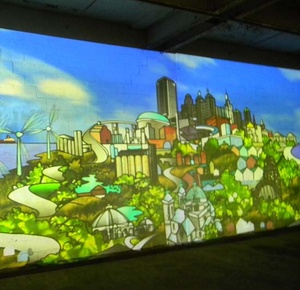 A mural of Buffalo that changed slowly at the 2013 festival. - Photo by Gregory Deibel
A mural of Buffalo that changed slowly at the 2013 festival. - Photo by Gregory Deibel
The City Of Night Art Festival features live music, theater and dance performances, an art fair, interactive art and cultural booths, food trucks, and a beer and wine tent.
Food trucks that set up at the festival are: Lloyd’s Taco Truck, The Whole Hog, Rolling Joe’s, Roaming Buffalo, Thai Me Up and Amy’s Truck.
The Main Stage of the City Of Night Art Festival holds musical performances each year. Last year, there were performances by Why Not, Tom Stahl and the Dangerfields, The Leftovers, Aircraft, Cowboys of Scotland, The Albrights, Forealists, Lazlo Hollyfeld, and Projex.
The City of Night also hosts many interactive booths for cultural organizations. Cultural organizations that attended City of Night last year include Western New York Artist Group, Regional Institute, Just Buffalo Literary Center, PUSH, Hispanic Heritage Council, Communify Buffalo, Buffalo Niagara, Riverkeeper, Techne Institute for Art and Emerging Technologies at the University at Buffalo, Westminster Economic Development Initiative and Energy, Old First Ward Community Center, Jewel of India, Buffalo Car Share, Buffalo Arts Studio, Buffalo by Choice, and Citybration.
Tours of Silo City hosted by Explore Buffalo Tours are held the morning of the City of Night Art Festival. The “Silo City: Vertical” tours take visitors to the top of the Perot and American Grain Elevators. Tours are priced at $50 ad $40 for students. The tours begin at 6:00 AM and end at 8:30 AM. The “Silo City: Grounded” tours are a 90 minute walking tour of Silo City. Visitors are given a history of the grain elevators. Costs for these tours are $15 and $5 for students. These tours begin at 9 AM, 11 AM, and 1 PM.
Pertaining to City of Night's environmental concerns:
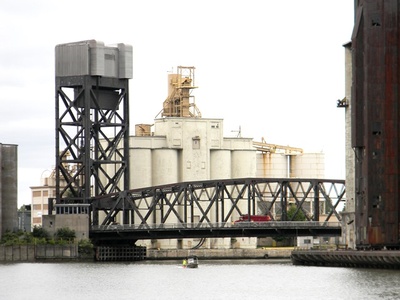 Photo by Gregory Deibel“Keeping the focus on sustainability, City of Night will be composting, recycling and utilizing biodegradable cups for beverages. The main stage will also be powered by solar panels. Organizers are encouraging guests to bike to the event if possible. GOBike Buffalo will be hosting guided bicycle rides to the event from Shea’s on Main Street, which will depart at 5 p.m., 7 p.m. and 9 p.m. They’ll also be offering a bike valet at the event so guests can have their bikes securely stored while they wander the grounds. NFTA will also provide a special bus route from Mohawk and Washington to Childs Street which will run from 7 to 11 p.m.”
Photo by Gregory Deibel“Keeping the focus on sustainability, City of Night will be composting, recycling and utilizing biodegradable cups for beverages. The main stage will also be powered by solar panels. Organizers are encouraging guests to bike to the event if possible. GOBike Buffalo will be hosting guided bicycle rides to the event from Shea’s on Main Street, which will depart at 5 p.m., 7 p.m. and 9 p.m. They’ll also be offering a bike valet at the event so guests can have their bikes securely stored while they wander the grounds. NFTA will also provide a special bus route from Mohawk and Washington to Childs Street which will run from 7 to 11 p.m.”
From Buffalo Rising, "City of Night Gets Bigger and Better", Sara Maurer, August 2013.
Many coordinators worked together to make the City of Night Arts Festival. They include Dana Saylor, a founding member and the Event Coordinator, Marissa Lehner, also a founding member and the Site-Specific Coordinator, Tara Sasiadek, a founding member and the Community Interaction Coordinator, Marcus L. Wise, the Art Fair Coordinator, Jon Furman, the Graphic Designer, Christopher Sasiadek, the Cultural Coordinator, Beth Okonczak, the Merchandise Coordinator, C. Mari Pack, the Treasurer, Kisha Patterson-Tanski, the Site Planner, Yan Shmatnik, the Web Designer, Krystal Sondel, the Volunteer Coordinator, Leslie Fineberg, the Chair of Multidisciplinary Art, Amber Rampino, the Marketing Coordinator, Alexandra Farrington, the VIP Night/Food Coordinator, Seamus Gallivan, the VIP Night Assistant, Event Emcee, Suzanne Eberhardt, the Event Interior Designer, June Crawford, the Tour Coordinator, Suzanne and Michael Jascz, Bar Managers, Craig Freudenthal, the Lighting Designer/ Electrician, Darren Burns, the Main Stage Coordinator, and Steve Bystran, the Site Management Coordinator.
Interview with Dana Saylor, the Events Coordinator, by Gregory Deibel
How did the idea for City of Night transpire?
“I have been the events coordinator for the event since we created it and the group that I am part of that created the event overall is Emerging Leaders in the Arts of Buffalo, ELAB, and to give you little bit of background on how it started, I actually hosted three French film makers back in the summer of 2011 at my house… basically they went around Buffalo trying to understand Buffalo’s history and trying to find where it’s at now with industrialization. They met the owner of Silo City through that process… I was so curious about that and I got his contact information and the fall of 2011 was when ELAB went down to Silo City and we took our first tour. Jim Watkins is the site manager who lives there on the site, and he gave us a bunch of history and a bunch of different information about what they were hoping to do with the site. Up until that point the only collaborations they had done were like architectural so some of the UB graduate students were coming down and doing a lot of architectural research, but not a lot of that yet, so it was still urban explorers, photographers, and architecture students. And that was about all, there were some tours coming through there, but no events. They said propose any idea you want, let us know what you think would be cool down here, we know that you’re the artist and we’d love to hear your perspective on what can be done. All of us immediately thought this site is incredible it would be amazing for a big art party, but we didn’t have any money so it was really a moot point. So we decided that we’d put that on the back burner and that maybe think of some way we could do something in the future.
Then in March or April of the next year, 2012, I found out that the Erie Canal Harbor Development Corporation was giving out fall grants for Buffalo river programming, they wanted to link together the inner and outer harbor through programming and the arts and culture. The fall grants were probably no more than ten grand, but I saw that as a way to start the project.
So once I heard about that, I went through all the descriptions of the grant, I went to the ELAB team and I said there’s this grant, I think we can get it and I think that we should do the project. Tara Sasiadek who is now the president of ELAB, but at the time she was the vice president, she suggested the name City of Night because we talked about the metaphor the darkness Buffalo has experienced, and how it’s coming out of that darkness, and trying to improve and to revitalize; so I think it was very symbolic of what we saw happening not only at Silo City, but in the whole city and the region, so that’s where we got started."
Have you began to plan for next year yet?
"Oh yeah. We are not sure yet so I am hesitant to give you an exact date, but we want a July date because June is too early. We were kind of forced to move our date earlier last year when we really didn’t wish too, so we will say July 2015 is reasonable to estimate."
Are you guys changing anything about the festival next year?
"There is going to be lots of changes next year, I don’t know if I’m eligible to say exactly what’s changing. The idea just to give you an idea just to give you a sense is City of Night what began as a big art party really ended up becoming something that we consider to be a place-sculpting experience. When I say that I mean, focusing peoples attentions, getting them to feel an emotional connection with the place, revitalizing it through arts and activities, and to reclaim what is kind of publicly theirs. So that sort of evolved, we didn’t think of that initially, we didn’t know what that really meant initially, we just wanted throw an art party, and so the process of city of night has shaped all of us and our group and it has changed our perspective of what we are as a group, what our purpose is. So the idea of City of Night is one that may be pulled around to different sites potentially; and draw the attention, make a change, revitalize, and perhaps through that process. We don’t know exactly what that means for us completely yet, but we are examining that as an idea of how to move forward. The philosophy of the event is one of evolution."
What demographic did the majority of the attendees fall in to?
"It’s a huge demographic, it’s very widespread. We see people of all ages, backgrounds, ethnicities, geographic locations. I would like it to be more ethnically diverse; I feel like we are still working on our outreach, and trying to make it something that is accessible to everyone in the city. There is public transportation to that site, but it’s be a little challenging sometimes or intimidating because of where it is. We saw people with baby strollers, and people who came from way out of town, and people who lived here their whole lives. It was very gratifying to see that very wide demographic spread."
In what ways are you trying to get the word out about City of Night?
"We tend to market through social media mostly, and through word of mouth. We never really had the budget to do official advertising; I don’t know if that’s really what we really want. That comes with greater sponsorship and greater awareness, but I kind of like the idea of it being under the radar, and people had to sort of look for it a bit. When you hear about it you’re like what is that? And it makes you kind of curious because you don’t know everything about it and you want to go because you are so sensationally curious."

